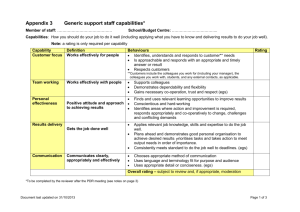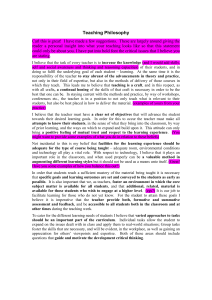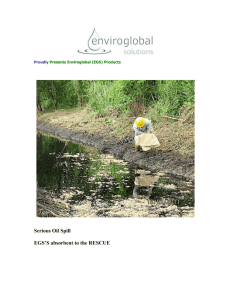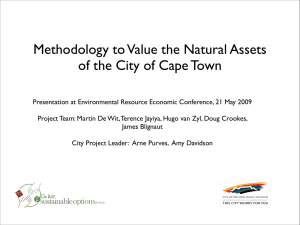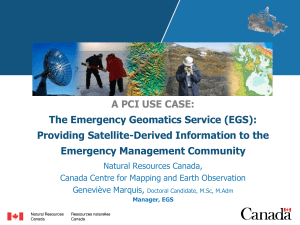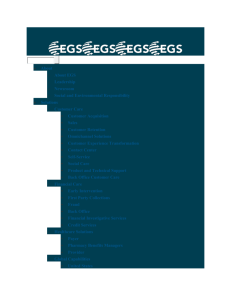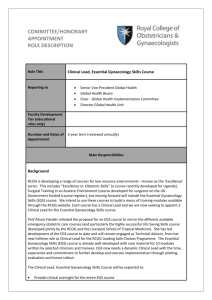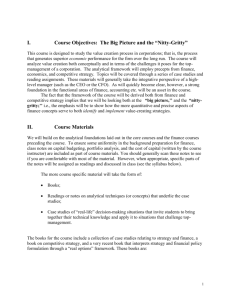Testing a Methodology to Value the City of Cape Town’s Natural Environment
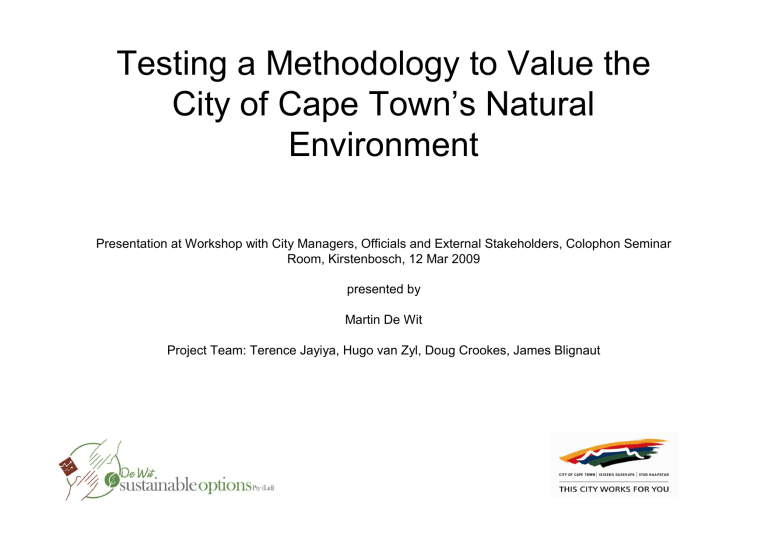
Testing a Methodology to Value the
City of Cape Town’s Natural
Environment
Presentation at Workshop with City Managers, Officials and External Stakeholders, Colophon Seminar
Room, Kirstenbosch, 12 Mar 2009 presented by
Martin De Wit
Project Team: Terence Jayiya, Hugo van Zyl, Doug Crookes, James Blignaut
“No company would stay in business long if its management did not know how much product was being produced, how much it cost to produce it, or the market price for the product. ...Why should we treat our natural capital – capital that sustains life on the planet – any differently?”
From Nancy Olewiler
“The value of natural capital in settled areas of Canada”
Human society is highly dependent upon ecosystem goods and services which are in turn dependent upon biodiversity rich and resilient ecosystems. However, many of these goods and services are public goods with no market and no price. As a result they are not recognised by our economic compass.
It is possible to develop economic tools and to build policies which take proper account of the real value of biodiversity... However, it will be a political choice as to whether to use these tools and to apply these policies.
Pavan Sukhdev - Leader of European Commission’s
The Economics of Ecosystems and
Biodiversity (TEEB) project
Institutions to capture value
• Conservation and Wetland Banking
• Biodiversity credits and offsets
• Tradable Development Rights
• Nutrient, salinity trading
• Conservation Easements
• Carbon cap-and-trade system
• Trading of carbon credits under CDM/JI
• Water pricing and trading
• Payments for hydrological services
• Community benefit sharing from protected areas
• Progressive public budgeting
Need to balance with inherent public good character of many natural assets!
Project phases
•
Phase One: International Review (finalised)
•
Valuation techniques, pros and cons; data requirements
•
Phase Two: Consultation (finalised)
•
Workshops with line functions; participatory approach
•
Phase Three: Methodology (in progress)
•
Build a consolidated methodology.
•
Phase Four: Pilot Valuation (in progress)
•
Demonstrate & test valuation methodology
Project Planning
Expert input
Client testing
Sept - Oct 08 Nov 08 Dec 08 - Jan 09 Feb - Mar 09 Apr - Jun 09
Succession of tasks
cost -
Natural Assets in the City
• Water
–Streams, lakes & wetlands
–Near-shore coast
• Atmosphere
– Clean air
• Biota (fauna & flora)
– Municipal parks
– Natural areas and Reserves
– Sports grounds
• Land & soil
Functions and EGS
Supporting, regulation, provisioning and cultural functions => EGS
Functions
Cultural Functions
Goods and services (examples)
Providing opportunities for cognitive development
19 Aesthetic information Enjoyment of scenery (scenic roads, housing, etc.)
20 Recreation Travel to natural ecosystems for eco-tourism, outdoor sports, etc.
21 Cultural and artistic information
22 Spiritual and historic information
Use of nature as motive in books, film, painting, folklore, national symbols, architect., advertising, etc.
Use of nature for religious or historic purposes (i.e. heritage value of natural ecosystems and features)
23 Science and education Use of natural systems for school excursions, etc.
Use of nature for scientific research
EGS & Human wellbeing
EGS in City - classified
Cultural related
Use of scenic areas for enjoyment/relaxation
Regulation related Habitat/space related Provisioning related
Use for School excursion Water for consumption Space for biota to live and reproduce Fuel and energy
Travel to Historic/Religious sites Storm water purification/drainage Conservation of living resources Material for craft, and fashion
Preventing flooding of areas Small scale urban farming
Use in the production of films/events Pollution abatement
Use in advertising and books Healthy soils for production
Beauty, inspiration and recreation Oxygen production
Use or scientific research Waste assimilation
Plant or animal material for medicines
Wild flowers for harvesting
Resources for collection
Benefitting both poor and wealthy in different ways, e.g. meeting some basic needs
Regulating
Supporting Services
Photosynthesis
Soil Formation
Primary production
Nutrient cycling
Water cycling
Provisioning
Water regulation (flows, etc.)
Natural hazard regulation (floods, etc.)
Water purification and waste treatment, assimilation
Erosion regulation
Pollination
Disease regulation
Pest regulation
Climate regulation - local (air quality)
EGS & Users in
Cape Town
Climate regulation - global
Space for biota to live and reproduce (refugia)
Fresh water provision
Fuelwood provision
Classified under ‘residents’ are:
•recreational and sporting groups
•harvesters, fishers and small producers
•educational groups
•cultural and religious groups
•property owners
•low income groups Building materials provision (wood, sand, etc.)
Wild flowers for harvesting
Provision of plant, animal material for medicines and biochemicals
Provision of materials for craft, fashion (e.g. shells)
Fish and marine resources
Genetic resources with potential pharmaceutical and other biochemical uses
Small scale urban farming
Classified under ‘key commercial groups’ are:
•tourism & recreation
•film, advertising and events
•arts & crafts
•real estate
•construction and manufacturing
•urban agriculture
•fishing
Recreation and tourism
Provision of inspirational beauty
Aesthetic values and sense of place
Educational uses (e.g. school excursions, scientific research)
Cultural (information)
Use in cultural and artistic practices and ceremonies
Use in religious practices and ceremonies
Use in productions (film & events), advertising and publications
Classified under ‘key public bodies’ are:
•Economic development
•Health and welfare
•Disaster Management
•Water
•Waste
•Conservation
Where does this all leave us?
•
Premise: Investment in natural assets enhance ecosystem functions, improve quantity and quality of goods and services and increase human well being
•
The value of the metropole’s natural assets is far bigger then charismatic icons such as Table Mountain National Park, whales and the value of niche-market eco-tourism only!
•
It often includes services that we take for granted (e.g. air that we breath, water that we drink, fertility of our soils, productivity of our fauna & flora) and value only when we have lost them and face the costs of engineering a solution (if at all possible)
•
Possible litigation if clean and healthy natural environment is pressured to such an extent that only sub-standard services can be delivered
•
By nature, Environmental Goods and Services are delivered free of charge. Capital and labour costs may be needed to bring those services to people.
•
Increased pressure and scarcity, however, increases the risks of failure, and hence rises the costs of EGS provision.
Summary of valuation studies in the
Cape Town metro
ha Low
R/ha
High
Average value
2007 R million
Valuation
Technique
Reserves
Mountain fynbos
Lowlands fynbos
Strandveld
Renosterveld
Wetlands
3912
291
5364
42
4626
1165
1165
1165
-
2533
7081
7081
7081
-
75159
16.1
1.2
22.1
?
179.7
CVM
CVM
CVM
HP & CVM
Recreational
Beaches
Parks 1
Sports fields
Vacant land 1
1
-
1962
260.4
7729.8
-
3181
19563
-6082
-
104239
36570
1021
54.5
105.4
7.3
-19.6
TCM
HP & CVM
HP & CVM
HP & CVM
Other
Agriculture 1
Geological
1 Metro South and South East only
3265.9
-
937
-
57684
-
95.7
?
CVM
HP
Notes
The direct and indirect use values associated with nature based tourism, fishing and other commercial sectors are not reported and are likely to be significant.
Illustrative business case
Natural Assets
Environmental
Values (Rm pa,
2007)
City expenditure
(Rm, 2007/8,
OPEX + CAPEX
Environmental resources
>274 64
Other expenditure
??
Benefit: Cost
(2007)
4.3
Wetlands 180 ..
Nature Reserves
Beaches
..
Agricultural fields
..
95
39
55
..
0
..
..
Note: Static analysis for illustrative purposes only.
Methodology for EGS valuation
• First, estimate relative importance of natural assets for EGS
• Second, estimate importance of EGS to beneficiaries/users (matrix EGS/Users)
– Residents, commerce, public bodies
– Identify levels of dependency
– Users at different levels (municipality, regional, national, global)
• Third, establish links closest to EGSs and development objectives
– Strategic objectives in the IDP (City Dev Strategy?/Mun Spatial Dev
Framework?)
– General: Identify essential services and acceptable levels of service to meet legal standards, human needs and development objectives
• Fourth, select EGS with mandate & ability to influence through management
– City’s Environmental mandate
– City’s capacity/ability to influence
– Biophysical and socio-economic boundaries of the system
– Services that have a high amount of sunk investments can be prioritised
Methodology (ctd)
• Fifth, looking into the future: assess ability of ecosystems to yield a sustainable flow of
EGS and prioritise according to risk
–Prioritise those services that score high on ecological and socio-economic risk (signalling potential problems with a sustained flow of ecosystems goods and services and a potential high loss of social welfare)
• Sixth, apply valuation techniques to selected valuation case studies
Selection for business case: strong cases first
• Where there is a clear link between City’s natural assets and EGS
• When EGS benefit a high number of people and/or has a high anticipated value to beneficiaries
• When EGS are clearly linked to the City’s socio-economic development objectives
• Those EGS for which the City has a clear mandate and which the City is able to influence
From Valuation to Budget Impact
• Clear, long-term vision on development and natural assets?
–expansion/maintenance
• Make link development objectives and natural resources explicit
• Approaching decision makers (UNDP/UNEP
2008):
– Targeted data and information (selection)
– Clear reasons (for increased budget)
– Relevant information only (less is more)
– Credible data and process (sources,
Key references
European Commission, 2008. The economics of ecosystems and biodiversity (TEEB). Interim Report.
UNDP/UNEP. 2008. Making the Economic Case – a primer for mainstreaming environment in national development planning. The UNDP-
UNEP Poverty-Environment Initiative.
Netherlands Commission for Environmental Assessment (NCEA). 2008.
Valuation of Ecosystem Services & Strategic Environmental Assessment.
Lessons from Influential Cases. Utrecht: NCEA.
Introduction to facilitation
• Need your insights into relative importance of EGS
– to beneficiaries
– to development objectives
– within environmental mandate and City’s ability to influence
– in terms of ecological and socio-economic risks
Method: Rapid participatory assessment
• Participatory Rapid Appraisal (PRA) is a qualitative survey methodology tool utilised by many organisations including World Bank, Action Aid, Aga Khan
Foundation, Ford Foundation, GTZ, SIDA, UNICEF, UNDP and UNCHS (Habitat), to formulate solutions to identified problems.
• The main component tools used by the World Bank in PRA include semistructured interviewing, focus group discussions, preference ranking, mapping and modeling, and seasonal and historical diagramming.
• We did a first round of interviewing, now:
– Focus group discussions
– Preference ranking
Logistics & outcome
• 5-7 people per group
• 60 minutes
– EGS & Users (20min)
– EGS & Dev Obj (10min)
– EGS & Mandate/Influence (15min)
– EGS & Risks (15min)
• Outcome:
– Priorities with motivation (labtop)
• Report back per group
• Short discussion
